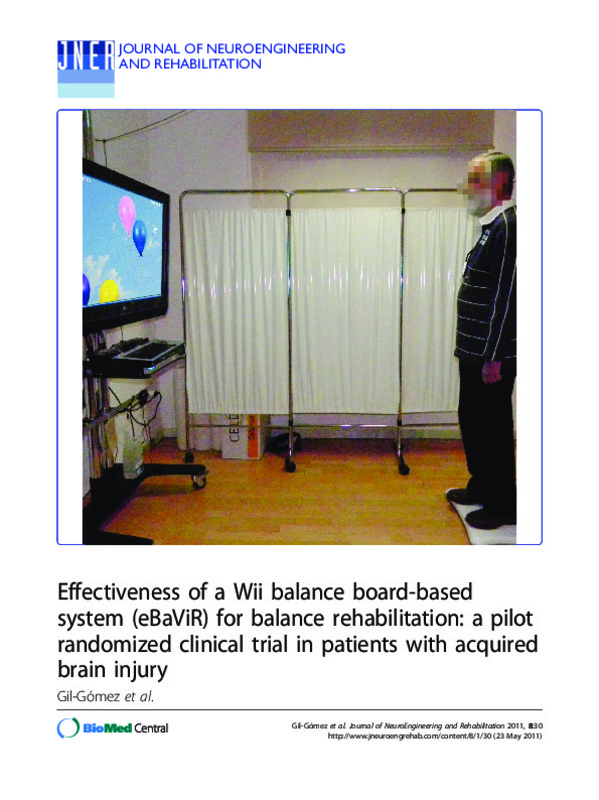Nichols-Larsen, D. S., Clark, P. C., Zeringue, A., Greenspan, A., & Blanton, S. (2005). Factors Influencing Stroke Survivors’ Quality of Life During Subacute Recovery. Stroke, 36(7), 1480-1484. doi:10.1161/01.str.0000170706.13595.4f
Teasell, R., Meyer, M. J., McClure, A., Pan, C., Murie-Fernandez, M., Foley, N., & Salter, K. (2009). Stroke Rehabilitation: An International Perspective. Topics in Stroke Rehabilitation, 16(1), 44-56. doi:10.1310/tsr1601-44
Sveistrup, H. (2004). Journal of NeuroEngineering and Rehabilitation, 1(1), 10. doi:10.1186/1743-0003-1-10
[+]
Nichols-Larsen, D. S., Clark, P. C., Zeringue, A., Greenspan, A., & Blanton, S. (2005). Factors Influencing Stroke Survivors’ Quality of Life During Subacute Recovery. Stroke, 36(7), 1480-1484. doi:10.1161/01.str.0000170706.13595.4f
Teasell, R., Meyer, M. J., McClure, A., Pan, C., Murie-Fernandez, M., Foley, N., & Salter, K. (2009). Stroke Rehabilitation: An International Perspective. Topics in Stroke Rehabilitation, 16(1), 44-56. doi:10.1310/tsr1601-44
Sveistrup, H. (2004). Journal of NeuroEngineering and Rehabilitation, 1(1), 10. doi:10.1186/1743-0003-1-10
Holden, M. K. (2005). Virtual Environments for Motor Rehabilitation: Review. CyberPsychology & Behavior, 8(3), 187-211. doi:10.1089/cpb.2005.8.187
Crosbie, J. H., Lennon, S., Basford, J. R., & McDonough, S. M. (2007). Virtual reality in stroke rehabilitation: Still more virtual than real. Disability and Rehabilitation, 29(14), 1139-1146. doi:10.1080/09638280600960909
Haas, B. M., & Burden, A. M. (2000). Validity of weight distribution and sway measurements of the Balance Performance Monitor. Physiotherapy Research International, 5(1), 19-32. doi:10.1002/pri.181
Srivastava, A., Taly, A. B., Gupta, A., Kumar, S., & Murali, T. (2009). Post-stroke balance training: Role of force platform with visual feedback technique. Journal of the Neurological Sciences, 287(1-2), 89-93. doi:10.1016/j.jns.2009.08.051
Deutsch, J. E., Borbely, M., Filler, J., Huhn, K., & Guarrera-Bowlby, P. (2008). Use of a Low-Cost, Commercially Available Gaming Console (Wii) for Rehabilitation of an Adolescent With Cerebral Palsy. Physical Therapy, 88(10), 1196-1207. doi:10.2522/ptj.20080062
Yong Joo, L., Soon Yin, T., Xu, D., Thia, E., Pei Fen, C., Kuah, C., & Kong, K. (2010). A feasibility study using interactive commercial off-the-shelf computer gaming in upper limb rehabilitation in patients after stroke. Journal of Rehabilitation Medicine, 42(5), 437-441. doi:10.2340/16501977-0528
Clark, R. A., Bryant, A. L., Pua, Y., McCrory, P., Bennell, K., & Hunt, M. (2010). Validity and reliability of the Nintendo Wii Balance Board for assessment of standing balance. Gait & Posture, 31(3), 307-310. doi:10.1016/j.gaitpost.2009.11.012
Young, W., Ferguson, S., Brault, S., & Craig, C. (2011). Assessing and training standing balance in older adults: A novel approach using the ‘Nintendo Wii’ Balance Board. Gait & Posture, 33(2), 303-305. doi:10.1016/j.gaitpost.2010.10.089
Shih, C.-H., Shih, C.-T., & Chiang, M.-S. (2010). A new standing posture detector to enable people with multiple disabilities to control environmental stimulation by changing their standing posture through a commercial Wii Balance Board. Research in Developmental Disabilities, 31(1), 281-286. doi:10.1016/j.ridd.2009.09.013
Shih, C.-H., Shih, C.-T., & Chu, C.-L. (2010). Assisting people with multiple disabilities actively correct abnormal standing posture with a Nintendo Wii Balance Board through controlling environmental stimulation. Research in Developmental Disabilities, 31(4), 936-942. doi:10.1016/j.ridd.2010.03.004
Folstein, M. F., Folstein, S. E., & McHugh, P. R. (1975). «Mini-mental state». Journal of Psychiatric Research, 12(3), 189-198. doi:10.1016/0022-3956(75)90026-6
Geurts, A. C. H., de Haart, M., van Nes, I. J. W., & Duysens, J. (2005). A review of standing balance recovery from stroke. Gait & Posture, 22(3), 267-281. doi:10.1016/j.gaitpost.2004.10.002
Marsden, J. F. (2005). The vestibular control of balance after stroke. Journal of Neurology, Neurosurgery & Psychiatry, 76(5), 670-679. doi:10.1136/jnnp.2004.046565
Perron, M., Malouin, F., & Moffet, H. (2003). Assessing advanced locomotor recovery after total hip arthroplasty with the timed stair test. Clinical Rehabilitation, 17(7), 780-786. doi:10.1191/0269215503cr696oa
McDowell, B. C., Kerr, C., Parkes, J., & Cosgrove, A. (2005). Validity of a 1 minute walk test for children with cerebral palsy. Developmental Medicine & Child Neurology, 47(11), 744. doi:10.1017/s0012162205001568
O’Shea, S. D., Taylor, N. F., & Paratz, J. D. (2007). Measuring Muscle Strength for People With Chronic Obstructive Pulmonary Disease: Retest Reliability of Hand-Held Dynamometry. Archives of Physical Medicine and Rehabilitation, 88(1), 32-36. doi:10.1016/j.apmr.2006.10.002
Tyson, S. F., Hanley, M., Chillala, J., Selley, A. B., & Tallis, R. C. (2007). The Relationship Between Balance, Disability, and Recovery After Stroke: Predictive Validity of the Brunel Balance Assessment. Neurorehabilitation and Neural Repair, 21(4), 341-346. doi:10.1177/1545968306296966
Brooks, D., Davis, A. M., & Naglie, G. (2006). Validity of 3 Physical Performance Measures in Inpatient Geriatric Rehabilitation. Archives of Physical Medicine and Rehabilitation, 87(1), 105-110. doi:10.1016/j.apmr.2005.08.109
Jørgensen, H. S., Nakayama, H., Raaschou, H. O., Vive-Larsen, J., Støier, M., & Olsen, T. S. (1995). Outcome and time course of recovery in stroke. Part II: Time course of recovery. The copenhagen stroke study. Archives of Physical Medicine and Rehabilitation, 76(5), 406-412. doi:10.1016/s0003-9993(95)80568-0
Ferrarello, F., Baccini, M., Rinaldi, L. A., Cavallini, M. C., Mossello, E., Masotti, G., … Di Bari, M. (2010). Efficacy of physiotherapy interventions late after stroke: a meta-analysis. Journal of Neurology, Neurosurgery & Psychiatry, 82(2), 136-143. doi:10.1136/jnnp.2009.196428
[-]









